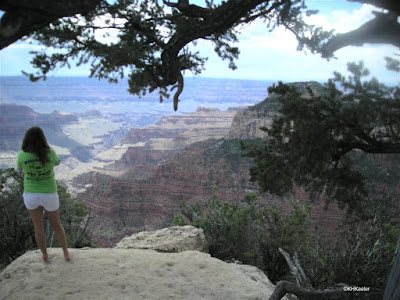 |
View from Alpine Visitor Center
Rocky Mountain National Park |
Recently, the Denver Post published a long article on the National Parks, emphasizing that visitation is up, resulting in very heavy use that is hard on vegetation and wildlife, overcrowds parking lots and creates traffic jams. (
Link National Parks Crisis, Nov. 21, 2018: I don't know if you can see it without a subscription but on The Guardian's website I think its accessible link; National Statistics link). Many of the problems can be solved by investing in infrastructure, but not access to solitude. It is harder and harder to have a wilderness experience.
 |
| Grand Canyon, from the North Rim |
I grew up in suburbia. I love the outdoors but do not have a strong personal history of hiking into the middle of nowhere to be alone "in nature." In fact, I am not comfortable when truly alone, say somewhere a half day's walk from another human. My kind of solitude is a rock a ten yards from the trail, where I can sit watching the birds in the creek and listen to the sound of the water. But lately I share the rock with people I don't know. It didn't bother me at the time, but it is part of the bigger picture of the heavy use of accessible wild places.
 |
| Grand Canyon from the North Rim |
Acccessible is probably the key to the problem. If good roads lead to beautiful vistas, anyone with a car can get there and I probably will not have the spot to myself. The farther I walk, or drive on poorly-maintained roads, the greater the chance I'll have solitude. Having to exert effort for escape is probably a good thing. But it does suggest we should use caution making every spot easy to reach.
Or maybe it argues for restricting access. If only a small number of people a day are allowed into an area, there will be solitude, at very least in comparison to having trails packed with visitors. But restricted access has its own complex problems.
 |
You can only reach the Maroon Bells Trail and Trailhead by bus
as soon as the tiny parking lot fills |
I want everyone to experience a hike up a mountain or down a beach or deep in a forest, so a good future will bring even more people to wild places.
 |
| A beach worth walking, Point Reyes, California |
I presume the best answer is a range of options. Some really easily accessible places that welcome hordes of people, some great places that few see because it is a long hard drive and harder climb to reach them. Wilderness advocates and land managers have been wrestling with these problems a long time. There are great ideas available but there is not always the will or funding to implement them.
Sitting indoors at my computer always improves the appeal of adventures. We should all see as much of the world as possible.
 |
| Alaska |
It is ever so worth seeing!
 |
Moab rock formation
(compare the size of the footprints in the foreground). |
But we have to be aware that we share the world's wild places with the other 7,700,000,000 people also living on our earth today. So we and they must enjoy without consuming. "Take only photos, leave only foot prints." That is harder than it sounds, when the wind grabs the powerbar wrapper or you find yourself far from a toilet. I won't chase a piece of paper down a cliff but I've packed out my used toilet paper for more than 40 years.
Think about the consequences of your actions when you are in a wild place and do what you can to minimize human impact on the stunning natural places that remain.
 |
| Atlantic coast, Massachusetts |
And see as many as you can!
Comments and corrections welcome.
Crisis in our national parks: How tourists are loving nature to death. The Denver Post Nov. 21, 2018 page 1; but credit refers you to The Guardian. on Nov. 20, 2018
link (search the Guardian US's website for "Crisis in our" if it doesn't come up easily.
Kathy Keeler, A Wandering Botanist








No comments:
Post a Comment